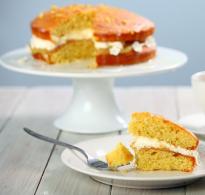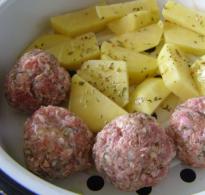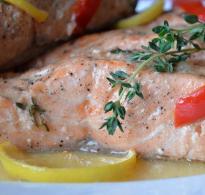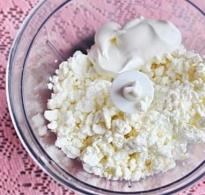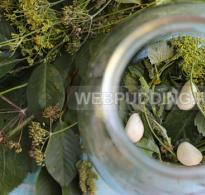How to cook sturgeon so as not to get poisoned. Sturgeon processing
Rare royal dinners did without this small species of sturgeon. The sterlet revealed its nutritional characteristics in a fried, stewed form. Even today they make sliced meat from it, smoke it, and use the insides, the same chord and caviar, for exquisite fish cakes and fillings in pies. Even the hero of Louis de Funes in one of the films sang the song, mentioning the "sturgeon piece." But how to properly gut the fish, so as not to damage the most valuable meat, but also not to cause harm to health?
The methods of cutting directly depend on what kind of dish you need to cook, maintain the integrity of the skin of the fish, or cut the fillet in portions. They buy whole sturgeon in stores. You can also catch a sterlet, but remember that it is listed in the Red Book of Russia. They are licensed to fish.
The love and respect for this sturgeon is also evidenced by its image on the emblems of Yeysk, Belozersk, Saratov.
Nutritional features of sterlet
A fish with a long nose, which the common people called the "snout", remains the smallest representative of sturgeon. More often on farms it is grown up to 50 cm in length, up to 2 kg in weight. But in the rivers you can find sterlet and large sizes - up to 16 kg and 2 meters. The sterlet is especially valuable for its meat:
1. Contains polyunsaturated fatty acids, they are responsible for the elasticity and strength of blood vessels. Omega-3 and omega-6 actively fight the deposition of harmful cholesterol.
2. Sterlet contains zinc, which is necessary for the normal functioning of the reproductive system and hematopoiesis; phosphorus involved in the absorption of calcium; chromium, which prevents obesity and the development of diabetes.
3. The nutritional value of sterlet meat is 17.5 g of protein per 100 g of fish, about 2 g of fat. Sterlet calorie - 88 kcal. Fish protein is digested faster than animal protein. Its use on some days of fasting remains an advantage.
But this product also has contraindications. So, sterlet should not be included in the diet of people with allergies to fish and diseases of the gallbladder and pancreas during an exacerbation.
What you need for proper cleaning and cutting at home
Fresh sterlet is prepared for processing in several ways. The most common of them is the butchering of fillets after preliminary freezing. Treatment with boiling water or coarse salt is also often used, but work with fresh fish is more popular.
Much depends on the further method of preparation. By the way, it will take a little time for it:
The sterlet is cooked for about 15-20 minutes, they take water for the fish soup one and a half times more than the fish lay.
Grilling fish steaks will take 3 to 5 minutes on each side.
It will take about 25 - 30 minutes to bake a whole sterlet in the oven, if the fish is more than 3 kg - up to 50 minutes.
Fresh fish: how to clean and cut?

To preserve the taste and vitamins, it is better not to freeze the sterlet, but to use it fresh. It is enough to leave the fish in the air - so it will “fall asleep”, and there will be no questions about its killing.
The skin of sturgeons is not covered with scales; instead, on the body of a sterlet there is a protective mucus and keratinized formations resembling thorns. You will have to remove them, the chord, entrails and gills.
Cleaning the fish goes like this:
1. They clean the mucus with a paper towel, sometimes it is advised to sprinkle the skin with coarse salt and leave for a quarter of an hour. Then the fish is washed under running water at room temperature.
2. With a sharp knife, cut off the keratinized formations on the back of the sterlet in a direction away from you.
3. Remove the side spikes with a fish scale knife. Also, knives with blunt blades are used for this purpose. You can hold the sturgeon for a couple of minutes in hot water at a temperature of 70 degrees. Then the formations will be separated even with your fingers, without the help of kitchen tools.
4. Next, gut the fish. An incision is made in the peritoneum and the entrails are taken out. To do this, wear thick rubber gloves. Do not forget to remove the inner film as well. After - wash the carcass with cold water.
5. Remove the screech. For this, two incisions are made on the back - in the area of \u200b\u200bthe transition of the body to the head and near the tail. The chord is carefully removed by hand, you can use a large needle or crochet hook. If the fish is large, make an incision in the middle of the back. Then the screech is extracted in two stages.
Important! If you plan to cook the fish in portions, then you can remove the chord from each piece separately.
An obligatory step is the removal of the eyes and entrails from the head, including the gills.
Frozen sterlet: how to clean?
If sturgeon representatives are first frozen, the cleaning process will become faster and easier. If the fish is supposed to be cooked in portions, and the appearance of the skin is not important, they use "grandmother's methods":
The frozen sterlet is immersed in hot water during the boiling period for 2-3 minutes - and the skin is removed with a stocking along with spikes, just remember to make cuts on the belly or near the head and tail.
In the defrosted carcass, the chord is removed, it is toxic. If it is damaged, and the contents fall on the fillet, you will have to abandon the fish.
If sturgeons are cleaned in advance for cooking in portions, you can immediately cut the cleaned carcass - cut into pieces, which are treated with basic seasonings and lemon juice, and freeze.
So, getting ready-made steaks from the freezer, send them to the grill or to the oven.
Preparation for cooking
Cleaning may require tools such as sharp and dull knives, cold and/or hot water, rubber gloves, and a large board.
The cutting itself depends on the culinary goals. For fish soup, you will need not only a carcass, cut into pieces of 5 cm, fins, a head, and a sturgeon tail will also add taste.
To cook steaks, steamed fish or a la grill, the skin is removed during the butchering process, dipping the sterlet in hot water. Then, with a sharp knife, cut it into thin pieces - 2-3 cm each.
In a different way, whole fish is prepared for baking. To do this, it is dipped in boiling water and the spikes on the back are manually removed. Then an incision is made along the belly and the entrails and chord are carefully removed, the skin is carefully removed. The sterlet fillet is finely chopped with a knife and this “stocking” is started with it.
Butchering a sterlet carcass does not take much time, and taking into account the intricacies of the process will help you prepare delicious dishes. Simple tips will be useful to everyone - both a novice cook and an experienced cook.
To keep the pieces of chopped sterlet aesthetically pleasing, they are placed in a colander and doused with hot water.
A separate topic is the removal of thorns from the body of sturgeons. They can be cut with a sharp knife away from you. It is better to perform this procedure when the fish has been previously frozen. Or you can dip the sterlet in boiling water and turn each spike on the back clockwise - and remove it. It is easily removed after heat treatment.
Interesting fact! The side spikes can be cleaned with a kitchen vegetable grater. If it is not there, they also clean it with a knife.
If they are going to cook stroganina, then the gutted, decapitated carcass without skin is frozen. Then they take it out of the freezer and put their head on the board. The cut off thin piece along the fish is left, the carcass is again cleaned in the cold.
The fresh head of sturgeon deteriorates quickly, therefore, after butchering it, it is first laid in broth or frozen.
Sturgeon cartilage is also useful, but if a large amount of fat is present on them, it is separated. Cartilage improves the taste of aspic and fish soup, and fat is suitable for giving softness and juiciness to fish cakes or minced meat for stuffing.
Sturgeon will always be a decoration of the festive table. Dishes from it amaze with taste and aroma, and fish protein benefits the human bone and muscle systems.
It is known that the sterlet remains an excellent appetizer, and the second, and the first course. But as soon as experience is gained in butchering a carcass, you can pamper your inner circle with stuffed sturgeon.
It is important to remember that heat-treated vegetables or cereals are placed inside, and for the first 20 minutes the fish is baked in foil - so that each ingredient is saturated with juices, then baked without it until a beautiful crust. It is impossible to spoil such a dish, but it is easy to surprise them!
Sturgeon can rightly be called an ancient fossil, since it is likely that its ancestors lived in the era of dinosaurs. It is unlike any other fish. Its skeleton consists of cartilage, and instead of a ridge, there is a dorsal string (chord) or screech, as it is usually called. The body is not covered with scales, and the skin is protected by five rows of bone growths - “bugs”. Therefore, they do not clean it like other fish. Find out how to do it, as well as how to properly butcher a sturgeon.
Sturgeon: the value of fish and the secrets of choice
Sturgeon is a unique fish, which is not in vain called royal. It is highly valued for dietary meat and black caviar - a special delicacy, the amount of which reaches 1/5 - 1/6 of the weight of the fish. Sturgeon is very tasty, nutritious and healthy. It contains proteins that are absorbed by the body by 98%, fatty acids, vitamins C, PP, B1, B2, as well as large amounts of sodium, phosphorus and calcium. Regular consumption of sturgeon meat lowers blood cholesterol levels and prevents heart attacks.
After cooking, the sturgeon loses relatively little in weight - about 15%, which is important, given its cost.
The inedible part is only 14%. Even cartilage and a vertebral string (squeal) are eaten after pre-treatment. From sturgeon any dish turns out tasty and refined. It is boiled, baked, fried, smoked, stuffed, poured and even barbecued. Sturgeon does not require a large amount of spices and aromatic herbs. Just a little salt, pepper and sprinkle with lemon juice - the taste will be divine!
Stuffed sturgeon - a truly royal dish
How to choose a quality sturgeon
Sturgeon can be bought live, chilled and frozen. Also, already cleaned and cut carcasses go on sale, but their cost will be much higher. It is very important to choose fresh and high-quality fish. Not only the taste of the future dish depends on this, but also the state of your health. It is best to buy sturgeon live or chilled. If you decide to buy live, then you should pay attention to his skin. The body should not have white and red spots - they can be signs of illness. Many wounds are also a bad sign, because they quickly develop an infection. Such mechanical damage and bruising must be removed during cutting. Pay attention to the behavior of the fish. She should actively move, and not "sleep" at the bottom of the aquarium.
Fresh chilled sturgeon can be bought whole carcass, butchered and cut into steaks. When choosing sturgeon, one must be very careful and do not buy fish if there are even the slightest signs of poor quality.
There are signs that indicate the freshness of chilled fish.
- Pleasant "fishy" smell. The presence of a foreign or unpleasant odor may indicate the end of the shelf life.
- The gills are dark in color without the presence of mucus. Greenish and gray hues are a sign that the fish has begun to spoil.
- The eyes should not be cloudy.
- Fresh sturgeon cut into steaks has skin tightly attached to the meat.
- When pressed with a finger, the flesh should quickly return to its previous form. If the deformation persists, you have stale fish in front of you.
- The belly of a butchered sturgeon should be pink without spots.
How to choose frozen sturgeon
Choosing a good frozen sturgeon is more difficult, because unscrupulous producers often try to hide the signs of low-quality fish by freezing.
- The presence of a thick layer of ice or snow indicates repeated freezing. The ice must be clean, free of dirt and blood.
- If you buy frozen fillets or steaks, then pay attention to their color. Yellowish and "rusty" stains indicate improper storage and re-freezing.
In any case, before purchasing a sturgeon, like any other fish, ask the seller for a quality certificate. It should contain complete information about the product and the date of sale.
Features of cleaning and cutting live and chilled sturgeon for cooking whole or in portions
The body of the sturgeon is covered with mucus, it is quite difficult to hold it in your hands. When you start cleaning for the first time, you risk spoiling the appearance of the fish and the quality of the cooked dish. This is a fairly strong fish, the bone growths that protect the body can hurt painfully. The leather is rough and feels like sandpaper. It will not be easy for a beginner, but there are simple ways to facilitate and speed up this process.
For kitchen tools you will need:
- knives - large sharp and with a narrow long blade (for screeching);
- kitchen scissors;
- scraper for cleaning fish;
- a hammer.
You can clean the fish in the washbasin, on the kitchen worktop, on a wooden board. The process will differ depending on the size of the fish.
How to clean, butcher and skin a small sturgeon
- If the fish is alive, you will have to stun it with a kitchen hammer wrapped in cloth. You cannot do this and there is no one to ask - wait until she "falls asleep" (without water, the sturgeon, like any fish, first falls asleep and then dies).
- We put the sturgeon in a deep bowl or washbasin and pour boiling water over it for a few seconds. After scalding, the skin turns white, becomes soft and easily lags behind the meat,
mucus is washed off with water, and bone plates move away from the body more easily.
The skin will easily fall behind the meat if you pour boiling water over the sturgeon
- With a large sharp knife, cut off a row of "bugs" on the back in the direction from head to tail. You can also separate each "bug" separately, which is quite easy to do after treatment with boiling water. In the second option, the fish will have a beautiful, neat appearance, which is important if you are going to stuff it and bake it whole.
Cutting the dorsal row of "bugs" is performed from head to tail
- We cut off the lateral and abdominal "bugs". They separate much easier. To do this, you can use a special scraper for cleaning fish.
- We clean the fish from the skin.
- We make two oblique incisions near the gills and cut the cartilage.
- We cut the belly to the end in the direction from the head to the anus.
- If there is caviar or milk, we take them out and clean them from the film. The belly is also well cleaned.
Pleasant surprise - belly full of valuable caviar
- We cut off the head with a sharp knife if we do not plan to cook the whole fish.
- We cut out the gills if we are going to use the head for making broth or fish soup.
- The fins can also be cut off so as not to get hurt during further processing of the fish.
- We remove the screech.
- Wash the fish thoroughly.
"Bugs" can be cut off without scalding, but it will be more difficult to do this. In addition, cutting the skin without damaging the pulp will not work. If the appearance of the fish does not bother you, you can safely clean it without using boiling water.
How to clean and gut a large sturgeon (more than 5 kg)
The processing of a large sturgeon will be different, as it will have to be cut into pieces.
- We cut off the head. To do this, pull the pectoral fin and with a sharp knife on both sides cut through the skin and flesh to the cartilage. Then we cut the cartilage and already remove the head.
- With the same knife we cut off a row of "bugs" on the back along with strips of skin. We cut off all the fins, except for the tail.
- We remove the screech.
- We cut the carcass into portions along the back, and then in half.
- With a sharp knife, separate the meat from the skin.
- Wash fish with cold water.
Pieces of meat can also be scalded to remove the skin later. But it will be more difficult to do this, since the skin of a large sturgeon is much thicker compared to a small one.
Important! All sturgeons spoil very quickly. After cleaning and cutting the fish, you need to either freeze it or start cooking immediately.
How to clean and cut frozen sturgeon at home
Sturgeon is often sold ungutted and frozen. Then it's even easier to clean. The fact is that sturgeon is very oily and for this reason it is much easier to clean sturgeon in “hard” form of ice cream than in fresh and “soft” form. You can do this before and after defrosting.
Cleaning sturgeon before defrosting
- We cut off the rows of bugs with a sharp knife immediately after the fish was taken out of the freezer.
- If we are going to remove the skin, then we scald the carcass with boiling water and clean it.
- Then let it thaw and start gutting. The entrails are very easy to remove when the fish is not completely defrosted.
- We defrost to the end, we take out the squeal and mine.
Step-by-step instructions for processing frozen sturgeon after defrosting
- We wait until the fish thaws in the air - 6–10 hours (depending on size).
- Cut off the head and pectoral fins with cartilage.
- We cut off the dorsal row of "bugs".
- Remove the rest of the fins along the line of their base and cut off the tail fin.
- We remove the screech (you can remove it in the same way as in the case of a live sturgeon).
- We scald and remove the lateral and abdominal "bugs".
- We clean from skin and mucus.
- Wash thoroughly in cold water.
After cleaning and gutting, the fish is almost ready for cooking. Its further cutting will depend on what you are going to cook:
- if you just want to fry, then cut into portions without cutting the fins;
- if the fish is quite large, then it is better to cut off the head and fins (they can be used for fish soup).
Sturgeon may not be cleaned. After boiling, the "bugs" and the skin will become so soft that you can even remove them with your fingers.
The right way to clean and cut sturgeon - video
Removal of squeal and its further use
It has long been used in cooking. In industry, it is dried, tied into bundles and sent for sale. There is an opinion that if it is not removed, then the poison contained inside will definitely get into the meat and poison it. That is why in many sources it is recommended to extract the entire dorsal chord, avoiding breaks.
The sturgeon is a carrier of the botulism bacillus, which releases a particularly dangerous poison - botulinum toxin. It can easily penetrate into caviar, meat and chord, so it is so important to be careful when cutting fish and wash it thoroughly.
Experienced chefs always remove this part of the sturgeon, because during the cooking process it swells a lot, increases in length and crawls out through the meat. To get it after that, without completely spoiling the appearance of the dish, is quite difficult.
What can happen if you do not remove the screech before baking the fish - video
Ways to remove screeches: instructions with photos
- On the inside, in the middle (where an ordinary fish should have a backbone), we make two shallow cuts - one at the head and the other at the tail. Using the blade of a narrow, thin knife, we hook the squeal and pull it out with our fingers. You can use a special chef's needle. We draw out the squeal slowly and carefully so as not to tear.
Inside the sturgeon carcass, small cuts are made near the head and tail and the screech is carefully pulled out.
- We cut the pulp at the base of the tail around the squeal and pull it out by the tail. Before that, you need to either cut off the head, or make an incision near the head.
- You can remove it in another way. We cut the fish along the back, flatten it and take out the screech.
Removing the squeal is also possible after cutting the dorsal row of "bugs"
Before cooking, the vizigu must be thoroughly washed, squeezed out the contents from it and cleaned of the outer inedible layer, which is easy enough to do with your fingers or the blunt side of the knife. After that, it is boiled in salt water and used as a filling for various dishes or dried for later storage.
How easy it is to extract a screech and what you can do with it next - video
- To prevent the fish from slipping out of your hands during cleaning, it is better to wear special gloves. You can also use a paper towel or a piece of newspaper.
- Slime can be removed by wiping the carcass with a napkin or rubbing with coarse salt, and then rinsing under running water.
- If you decide to clean the sturgeon on the table, cover it with several sheets of newspaper and change them as they get dirty.
- Whitened skin after scalding is very easily removed with a brush for washing vegetables. You just need to "clean" the fish, as you clean the potatoes before baking in the "uniform".
- You need to clean the fish in the direction away from you, so as not to get hurt.
- When cutting the belly, one must be extremely careful not to damage the gallbladder. If the liquid that fills the bubble gets on the meat, it will become bitter and unfit for consumption.
- Always cut out the gills if you leave the head. With them, the dish can be bitter.
- Do not be lazy to get a squeal if you want the dish to look attractive. It can be dried and used in the future. In this form, it is stored for a long time.
- If there is caviar in the belly, it can be salted and later used for making pates or as an independent dish.
- Milk can also be salted, but they must be used as soon as possible. In the air, their taste deteriorates due to fat oxidation.
- Cartilage and strips of skin with bugs can be used to make broths and aspic fish.
- It is better to cut out places with bruises and injuries on the body of the sturgeon.
In order not to damage the gallbladder, it is worth knowing its location. It is located just after the pectoral fins, very close to the liver. That is why when eviscerating, you can not stick the knife too deep. Undoubtedly, the most delicious dishes are made from live, freshly caught fish. Do not risk eating sturgeon of dubious quality. Botulism pathogens can be found in its intestines, which can penetrate meat and caviar if the fish is stale.
Almost a master class from the rangers of the Partizan Forest Club, filmed during.
First of all, the sturgeon must be caught. As it turns out, this is not such an easy task. But let's assume that we successfully coped with this and here he is, a handsome man, in experienced hands.
Before butchering, the fish has to be killed, a simple extraction from the water is not enough for this, and the huntsman hits a small hammer at a certain point on the head of the fish. Ready!
The gills are removed first. If they are left, they will spoil the whole taste of the fish, because. bitter strongly. Plus sand. And blood. Strange thing, but there was practically no more blood during cutting. 
Then the fish is poured with boiling water, this is done not only to easily remove bone spikes from the carcass, but also to preserve the attractive appearance of the fish: if you do not clean off the mucus covering the carcass, then when cooking / frying, it forms gray nasty flakes. The spikes are cleaned with a special knife. 
Watering and cleaning :) 
Here is that spike from the guessing game :) 
After removing all the spikes, the carcass is opened and the insides are cleaned. Plast from the side of the abdomen exactly in the middle of the fatty layer of the spinal cartilage. Then deep incisions are made on the “back of the head” (well, if the fish had a back of the head, then it’s somewhere there) and tail, and a screech is pulled out through the hole in the back of the head - this is such a vein in the central cartilage. If you do not get the screech from the sturgeon, then the meat will become poisonous. 
What an assistant, but :)) Handsome, handsome, solid such. Waiting for his share. 
OK it's all over Now. After cutting, the fish is cut into portions for further cooking. 
Sturgeon is a large freshwater fish that in nature reaches very impressive sizes. Because of this, cooking a whole sturgeon is a rather big problem, but now in supermarkets it is possible to purchase live fish weighing 1.5–2 kg, which even a novice cook can bake at home.
How to clean a sturgeon
So that the scales, which are located along the sturgeon's ridge, depart well, pour boiling water over the carcass. Then clean the fish with a special knife. Remove the gills and eyes from the head.
Make an incision on the abdomen and take out all the insides. Rinse the fish thoroughly with cold water, first inside and then outside. Let the carcass dry. On the back to the ridge, make cuts every 3-5 cm (depending on the size of the servings). Now the fish is ready for cooking.
Sturgeon is a delicacy, the meat is tasty in and of itself, but adding spices and marinating it a little is still worth it, this will give the fish a special piquancy and aroma. To bake a whole sturgeon, you will need: - black pepper; - white pepper; - dried thyme; - dried parsley, dill; - lemon; - vegetable oil; - dry white wine; - greens.
Rub the carcass with salt, white and black ground pepper, sprinkle with dried herbs (dill, parsley, thyme). Drizzle the meat inside and out with lemon juice and dry white wine. Lubricate the skin with vegetable oil. Let the fish marinate a little, at room temperature 15-20 minutes will be enough.
Line a deep baking sheet with 2 layers of foil. Put the sturgeon on it belly down. Top with another sheet of foil and seal the edges.
Since the fish is large, it will not fit on a baking sheet even in its entire length, so lay the sturgeon in a semicircle
Heat the oven to 200°C. Place a baking sheet with sturgeon in it for 10 minutes. Then take out the fish, remove the top layer of foil. Reduce the temperature and place in the oven. This time, the fish should be baked until done. Turn off the oven and let the sturgeon rest in the oven for another 5-10 minutes.
Now the most crucial moment - you need to transfer the sturgeon to a dish so that the fish does not fall apart. Place the dish next to the baking sheet, bend it a little and carefully move the baked sturgeon along with the foil, which is then removed by lifting the fish with a spatula.
Decorate the dish with lemon, fresh herbs and vegetables. Cut the lemon into thin slices. Insert them into the incisions on the back of the sturgeon. Stick an olive in the eye sockets, you can prepare a special sauce. Put vegetables and parsley, lettuce around the fish and invite your loved ones to taste the royal dinner.
Fish dishes are a source of a large amount of vitamins and nutrients, which are so necessary for each of us. Nutritionists are sure: it is necessary to eat fish at least once a week, whether it is baked sturgeon or hake cutlets. But what to do if there is a very useful fish of the sturgeon family in the refrigerator, and there is absolutely no experience in its preparation? First of all, you need to figure out how to properly clean the sterlet, and then proceed to the study of recipes.
Sturgeon and its characteristics
Fish of the sturgeon family is a product that is not too cheap, but very useful. When buying sturgeon, housewives often choose sterlet. This fish is not as big as a sturgeon, and most often weighs 3-6 kilograms, which is quite enough for an average family dinner or a small picnic. The sterlet is easily recognizable. It is distinguished from other fish by:

Sterlet and other sturgeons are expensive for a reason. This type of fish is very whimsical to the environment in which it lives. Therefore, having bought a sterlet, the buyer does not have to think about the conditions under which it was grown or caught. In dirty and muddy water, this fish simply does not live. This delicacy product is also valuable because it is a source of vitamins, fatty acids and minerals. . All these useful elements have a positive effect on the human body and provide:
- good brain activity;
- no interruptions in the work of the heart;
- prevention of atherosclerosis;
- help in the fight against stress and depression;
- support for high mental stress.
Basic cleaning rules
 To understand how to properly clean and cut a sterlet at home, you should spend a little time preparing the fish itself and auxiliary tools.
To understand how to properly clean and cut a sterlet at home, you should spend a little time preparing the fish itself and auxiliary tools.
In order to butcher a sterlet, it is necessary to prepare a sharp knife and a large cutting board. Also, work gloves will not interfere, so as not to injure your hands on the sharp spikes of the fish.
Before cutting, it is necessary to inspect the carcass for external damage: if there are wounds and bruises on the skin, the fish may be infected.
Sterlet and other sturgeons are covered with a semblance of skin, so the question of how to clean sturgeon from scales disappears by itself.
First you need to defrost the sturgeon if you bought it frozen. If the sturgeon is alive, then, on the contrary, put it to sleep in the freezer for an hour. Then you need to follow the steps in this order:
- pour boiling water over the whole fish: this will help remove the mucus that covers the skin of the sterlet from the surface;
- cut off the "bugs" - these are bone shields on the back of the fish;
- remove the bugs on the sides. You need to do this from the tail to the head, as we remove the scales from an ordinary fish.
Then you can gut the carcass, like any other fish. To do this, a longitudinal incision is made on the belly from head to tail and the insides are removed. All actions must be done very carefully, since, firstly, it is necessary not to damage the gallbladder of the sterlet (if this happens, the meat will be bitter). Secondly, there may be milk or very tasty sturgeon caviar in the abdominal cavity, which are also better cooked in a beautiful “whole” form.
After removing the entrails, rinse the carcass under running water. Whether or not to remove the head of the fish depends on your dish. If you bake the whole sterlet in the oven, then the fish with the head will look quite organic.
Sturgeon screech
 Fish of the sturgeon family have one important feature that you need to know about when cutting. This is the presence of a screech - a tendon that is located along the ridge.
Fish of the sturgeon family have one important feature that you need to know about when cutting. This is the presence of a screech - a tendon that is located along the ridge.
In order to see it, it is enough to cut the tail of the fish. The incision must be made in a circle, very carefully, and then pry off the squeal with a knife and pull it out smoothly. You can use small tongs or pliers for this.
You can easily find a video on how to remove a screech from a sturgeon if you still have questions.
There is an opinion that the screech is poisonous, so it must be removed from the fish. In fact, earlier this part of the sturgeon was successfully used to prepare quite exquisite dishes, so the question of whether the screech is poisonous or not is doubtful.
It is more correct to say that the squeal deteriorates faster than the fish itself, so it is better to remove it and thereby extend the shelf life of the fillet.
After removing the squeal, the sterlet fillet is completely ready for further cooking. There are a lot of tips on how to cook sterlet correctly and tasty, but the choice of dish depends on your taste preferences.
Useful Tricks
It turns out that cleaning a sterlet is not difficult at all. But there are a few points that will greatly facilitate the cleaning process:

These tricks will help to significantly speed up the process and perform it efficiently. After all, a well-cleaned and butchered sterlet carcass is the key to a delicious dinner.
Attention, only TODAY!

